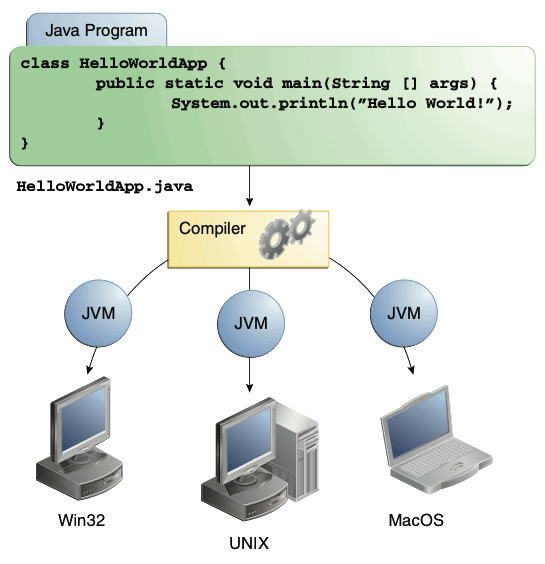About Java Technology
Java technology is both a programming language and a platform.Why Java Programming Language?
The Java programming language is a high-level language that can be characterized as following:
|
|
In Java programming language all source code is written in plain text with .java extension. The source file is complied into .class file by javac compiler.
e.g c:/MyProject/javac MyProgram.java
A .class file does not contain source code instead it contains bytecode-the machine level language of the Java Virtual Machine(JVM)
The java launcher tool then run your application with an instance of JVM
e.g c:/MyProject/java MyProgram
It is a platform independent i.e it can run on different operating systems. As Java VM is available on many different operating systems, the same
.class files are capable of running on Microsoft Windows, the Solaris™ Operating System (Solaris OS), Linux, or Mac OS
Why Java Platform?
The Java platform differs from most other platforms in that it's a software-only platform that runs on top of other hardware-based platforms.
The Java platform has two components:
The Java platform has two components:
- The Java Virtual Machine
- The Java Application Programming Interface (API)
Java Virtual Machine is base for the Java platform and is ported onto various hardware-based platforms.
The API is a large collection of ready-made software components that provide many useful capabilities. It is grouped into libraries of related classes and interfaces; these libraries are known as packages.

The API is a large collection of ready-made software components that provide many useful capabilities. It is grouped into libraries of related classes and interfaces; these libraries are known as packages.

The API and Java Virtual Machine insulate the program from the underlying hardware.
What Can Java Technology Do?
- Development Tools: The development tools provide everything you'll need for compiling, running, monitoring, debugging, and documenting your applications. As a new developer, the main tools you'll be using are the
javaccompiler, thejavalauncher, and thejavadocdocumentation tool. - Application Programming Interface (API): The API provides the core functionality of the Java programming language. It offers a wide array of useful classes ready for use in your own applications. It spans everything from basic objects, to networking and security, to XML generation and database access, and more.
- Deployment Technologies: The JDK software provides standard mechanisms such as the Java Web Start software and Java Plug-In software for deploying your applications to end users.
- User Interface Toolkits: The Swing and Java 2D toolkits make it possible to create sophisticated Graphical User Interfaces (GUIs).
- Integration Libraries: Integration libraries such as the Java IDL API, JDBC™ API, Java Naming and Directory Interface™ (JNDI) API, Java RMI, and Java Remote Method Invocation over Internet Inter-ORB Protocol Technology (Java RMI-IIOP Technology) enable database access and manipulation of remote objects.


0 Comments